One of the first things admirers or newcomers to our breed might notice about our horses is their abundance of long, silky hair. This characteristic exists for a practical reason, but nevertheless, it imbues the horses with an air of extravagance and exoticism. The next thing our dear admirers may notice is the complete, and deliberate absence of that same hair in certain individuals. This contrast between copious and complete lack of hair strikes newcomers as quite peculiar. What exactly is going on, here?
Like many aspects of Spanish horse culture, the traditional clipping of manes and tails follows a specific, and ancient protocol rooted in complete practicality. The abundance of fine, silky hair itself may seem a frivolous extravagance to the unacquainted, or even to fans of other sub-groups of Iberian horses, but in the region of southern Spain known as Andalucia, it is an essential characteristic intended to protect the horses against fairly extreme conditions and a blazing, nearly North-African sun, and the abundant flies and biting insects found in the countryside and swampy marisma.
Spanish Clipping Traditions
Article by Andalusian World Magazine for informational purposes only!
With summer temperatures regularly soaring above 100 degrees Fahrenheit in the summer and winter temperatures dipping below freezing, these unusual manes and forelocks provide âsunglassesâ for the eyes; a shade from the heat of the sun, insulation against the cold, and a natural fly screen. As an aside, the predominantly gray coats with black skin are also an adaptation for surviving the searing summer heat in as much comfort as possible. French cavalry trends introduced the relatively new practice of shaving the forelock, and subsequently the Spanish invented the now iconic and decorative mosquero (literally, âfly swatterâ); a forelock replacement.
So which horses are clipped, and why? Colts: Colts mane, tail, and forelock hair are completely shaven until one year of age, and then never again. Colts older than one year: Bridle paths of varying lengths may be clipped to just behind the ears, but tend not to exceed a few inches. No other hair is typically clipped.Why: When turned out in mixed age groups in large Spanish pastures, the age of the colts may be identified months later by the length of the hair. Once in a stable, bridle paths make wearing halters and bridles more comfortable, and expose the horses muscular poll, and slender throatlatch for admiration. Long hair becomes sun-bleached and tangled without regular maintenance, so shaving it eliminates this problem on horses turned out for lengthy periods of time.
Yearling Fillies: Fillies have their manes and forelocks shaven until one year of age. Tails are shaven, leaving a lion-like tassel at the very end of the tail. Why: Once again, large groups of mixed age fillies may be turned out together in vast areas, for long periods of time. They may be identified and sorted by age by the length of their hair. Additionally, arched crests are a hallmark of the Iberian breeds, but are typically found on mature stallions. Shaping a roached mane can create the aesthetic of a more shapely and arched neck on a mare or yearling colt. Two year old fillies: After one year, many choose to allow the forelock to grow to shade the eyes from sun and flies, while some continue to shave the forelock. Shaven forelocks are currently in vogue in the PRE show ring. Manes are shaven and shaped. Tails are shaven from the tail dock to the bottom of the vulva, and banged at, or above the hocks.Three year old fillies: Shaven manes, and tails neatly trimmed at a length between the hocks and pasterns, and shaven from the tail dock to the bottom of the vulva.Four year old mares and older: Shaven and shaped manes, tails banged at the heels, and shaven from the tail dock to the bottom of the vulva. Forelocks optional.Why: Shaving the tail from the tail dock to the bottom of the vulva prior to both foaling and live cover (breeding) aids in keeping the mare clean, tidy, and comfortable. Vet wrapping this region of the tail is a common alternative to shaving for unclipped mares of various breeds for the same function. Because mares are often turned out for long periods of time as adults during pregnancy and foaling periods, having little mane hair to tangle aids in providing comfort and tidiness. Live cover breeding is also complicated by full tails. Aesthetically speaking, a shaven tail will highlight the breed’s characteristic low set tails and rounded croups.
While even today Spanish horses are frequently raised out on the range in the old fashioned way, traditional clip jobs have persisted into the modern era of carefully managed stables. These specialized clip jobs have typified the breeds show ring aesthetics; especially with mares. Understanding where these traditions come from is all part of the fun of showing these magnificent animals. While some may choose to allow their mares to let their hair down, especially those who must deal with harsh climates, others delight in the now iconic aesthetics of the traditional Spanish clips.
The Andalusian, also known as the Pure Spanish Horse or PRE (Pura Raza Espanola), is a horse breed from the Iberian Peninsula, where its ancestors have lived for thousands of years. The Andalusian has been recognized as an individual breed since the 15th century, and its conformation has changed very little over the centuries. Throughout its history, it has been known for its prowess as a war horse, and was prized by the nobility. The breed was used as a tool of diplomacy by the Spanish government, and kings across Europe rode and owned Spanish horses. During the 19th century, warfare, disease and crossbreeding reduced herd numbers dramatically, and despite some recovery in the late 19th century, the trend continued into the early 20th century. Exports of Andalusians from Spain were restricted until the 1960s, but the breed has since spread throughout the world, despite their low population. In 2010, there were more than 185,000 registered Andalusians worldwide.
Strongly built, and compact yet elegant, Andalusians have long, thick manes and tails. Their most common coat color is gray, although they can be found in many other colors. They are known for their intelligence, sensitivity and docility. A sub-strain within the breed known as the Carthusian, is considered by breeders to be the purest strain of Andalusian, though there is no genetic evidence for this claim. The strain is still considered separate from the main breed however, and is preferred by breeders because buyers pay more for horses of Carthusian bloodlines. There are several competing registries keeping records of horses designated as Andalusian or PRE, but they differ on their definition of the Andalusian and PRE, the purity of various strains of the breed, and the legalities of stud book ownership. At least one lawsuit is in progress as of 2011, to determine the ownership of the Spanish PRE stud book.
The Andalusian is closely related to the Lusitano of Portugal, and has been used to develop many other breeds, especially in Europe and the Americas. Breeds with Andalusian ancestry include many of the warmbloods in Europe as well as western hemisphere breeds such as the Azteca. Over its centuries of development, the Andalusian breed has been selected for athleticism and stamina. The horses were originally used for classical dressage, driving, bullfighting, and as stock horses. Modern Andalusians are used for many equestrian activities, including dressage, show jumping and driving. The breed is also used extensively in movies, especially historical pictures and fantasy epics.
Pura Raza Espanola (PRE) horses
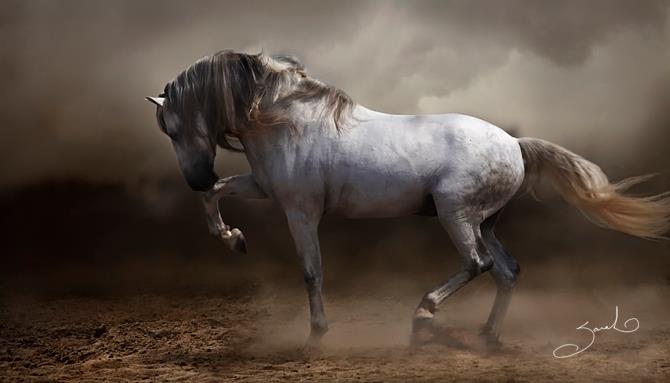
This is our first P.R.E. Stallion Electrizar. Picture is copyrighted, no publication rights per owner Mary Claeys


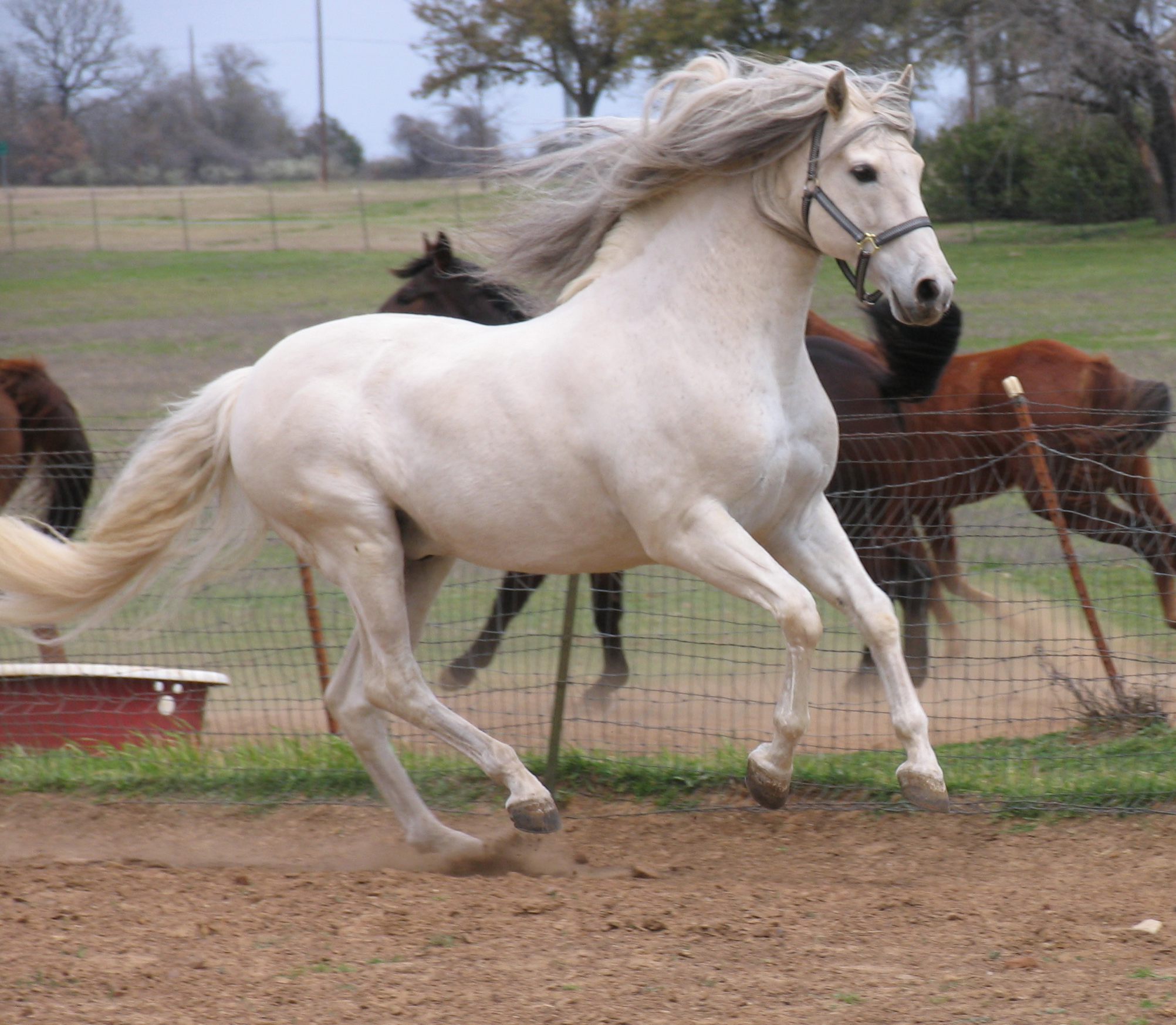
Braiding for Iberian and Baroque Show Horses
Article by Andalusian World Magazine for informational purposes only!
Show season also means it is braiding season, which can be a nightmare for owners (and grooms) of Iberian and Baroque horses with long, flowing manes and tails.
Luckily for us, Cesar Lerias, (Portuguese rider and trainer) has published YouTube videos on how to braid Lusitanos in the traditional style. For those of you who own a Lusitano, or compete in Working Equitation, Doma Vaquera, or Native/Heritage Tack and Attire classes, instructions on how to put up the tail will be of particular interest to you.
For those of you who show your horses at dressage shows and don’t want to cut or pull your horses mane, a running braid as demonstrated can be the perfect solution. If your horse has thick mane, it will make it very difficult to get a nice, smooth single running braid, so it is best to split the mane in half and do a braid on each side. For dressage, the tail is normally banged flat at the bottom and the hair around the top of the tail is trimmed or pulled to give a nice, neat appearance.
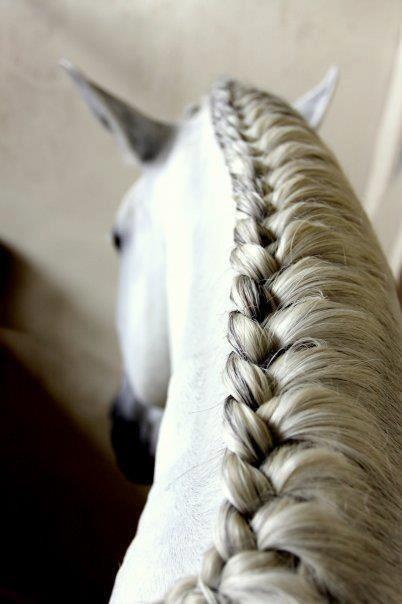
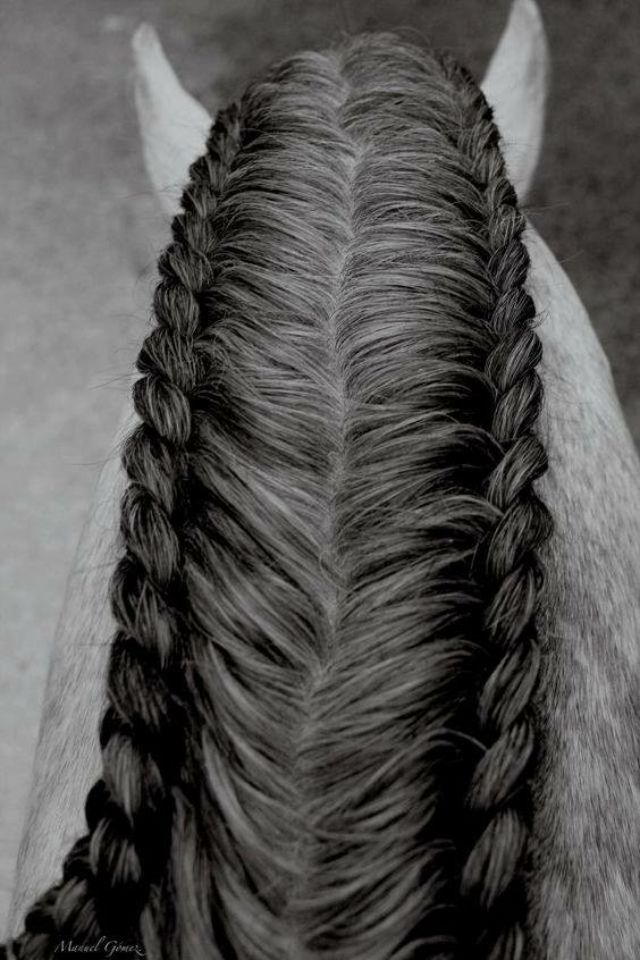
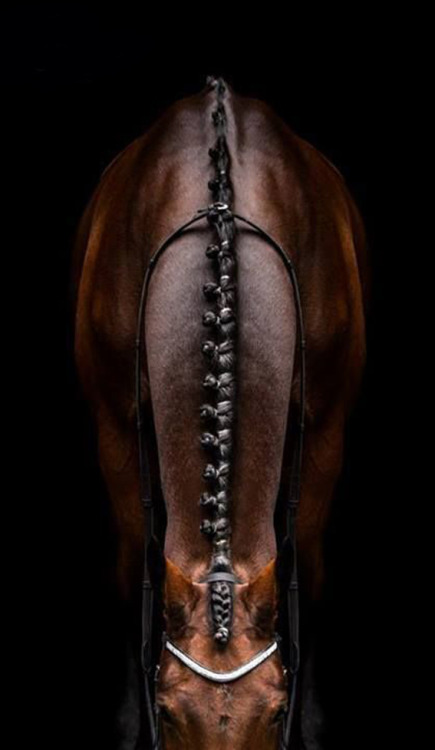
(Examples from the internet of a Running Braid, Dbl Running Braid, and buttons braids.)
If you are attending breed shows, here are some general rules on braiding protocol for the different types of classes offered:
Halter Classes No braids in mane or tail, unless you are showing in a Sport Horse In Hand class
Dressage Classes Such as dressage suitability, hack, etc braided mane and forelock, but not tail
Cool way to braid for Dressage Class https://www.facebook.com/100009335323782/videos/2391348384519649/
Hunt Seat Classes Braided mane and tail, braided only part way down as traditionally done in Hunter classes
Working Equitation, Doma Vaquera, Native/Heritage Tack and Attire Braided mane and tail to match whichever style you are representing.
Quick way to tidy up a show tail https://www.facebook.com/100009335323782/videos/2391348384519649/
Western Pleasure, Saddle Seat, Driving No braids in mane or tail
Although there are no rules as far as braiding is concerned, it is considered and unwritten rule that you braid for specific classes. Failure to do so most likely won’t result in penalization from a judge, but does not help to create that polished look you want for the show ring.
The secret to braiding well is practice, practice and more practice! Having a mane and tail that is not freshly washed and using hair product such as gel or spiking gel also helps. To get the mane to stay tight to the crest, use a step stool so you are standing above and slightly behind the horse while braiding.
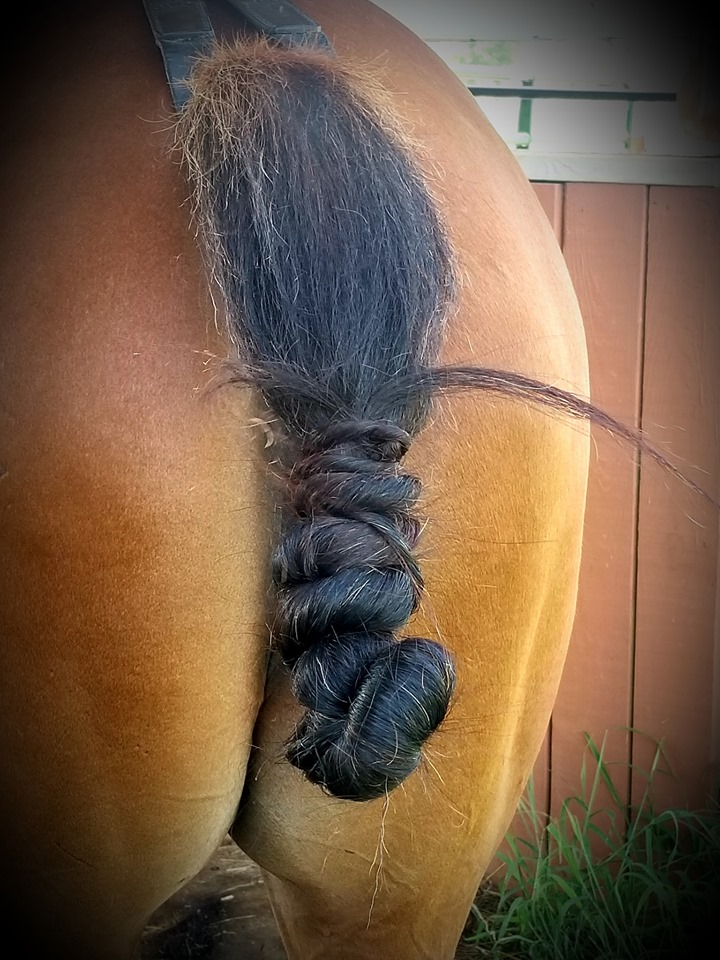
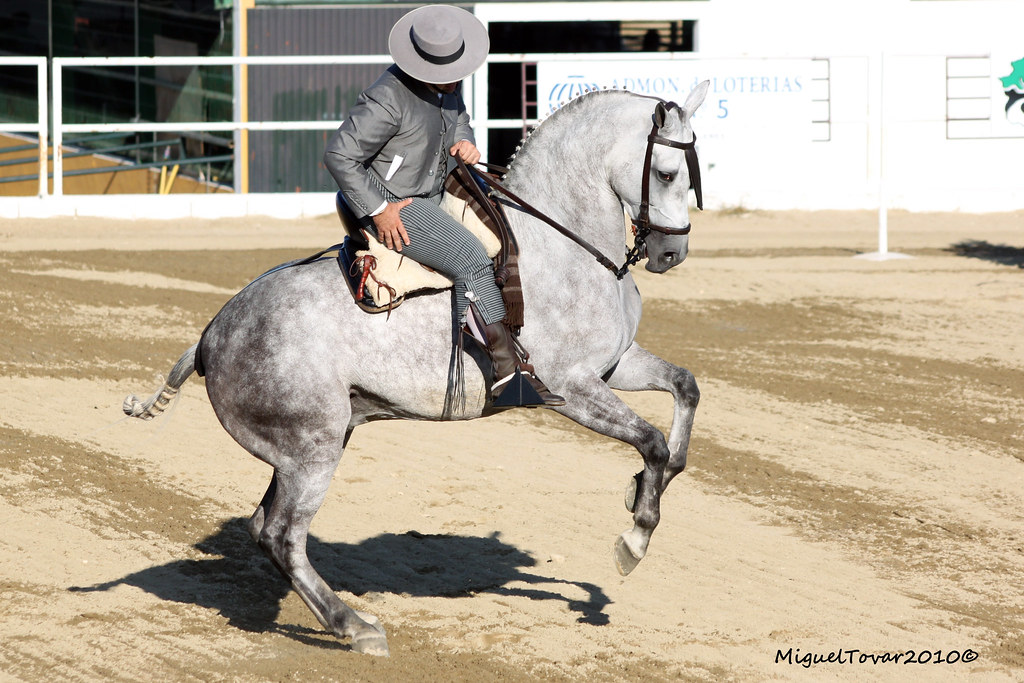
Bridled Passion Dressage
and Andalusian Farm
